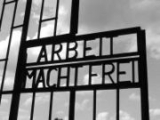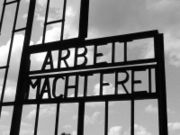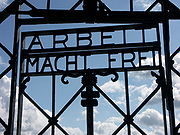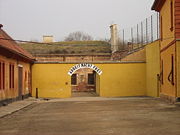
Arbeit macht frei
Encyclopedia

Nazi concentration camps
Nazi Germany maintained concentration camps throughout the territories it controlled. The first Nazi concentration camps set up in Germany were greatly expanded after the Reichstag fire of 1933, and were intended to hold political prisoners and opponents of the regime...
during the Holocaust, including most infamously Auschwitz I
Auschwitz concentration camp
Concentration camp Auschwitz was a network of Nazi concentration and extermination camps built and operated by the Third Reich in Polish areas annexed by Nazi Germany during World War II...
, where it was made by prisoners with metalwork skills and erected by order of the Nazis in June 1940.
The expression comes from the title of a novel by German philologist Lorenz Diefenbach
Lorenz Diefenbach
Georg Anton Lorenz Diefenbach was a German philologist and lexicographer, as well as a novelist associated with the German Nationalist movement. By career he was a pastor, like his father, and a librarian.-Biography:He was 12 years pastor and librarian at Solms-Laubach...
, Arbeit macht frei: Erzählung von Lorenz Diefenbach (1873), in which gamblers and fraudsters find the path to virtue through labour. The phrase was also used in French ("le travail rend libre!") by Auguste Forel, a Swiss psychiatrist, in his "Fourmis de la Suisse" (1920). In 1922, the Deutsche Schulverein of Vienna, an ethnic nationalist "protective" organization of Germans within the Austrian empire, printed membership stamps with the phrase Arbeit macht frei. It was adopted in 1928 by the Weimar government
Weimar Republic
The Weimar Republic is the name given by historians to the parliamentary republic established in 1919 in Germany to replace the imperial form of government...
as a slogan extolling the effects of their desired policy of large-scale public works
Public works
Public works are a broad category of projects, financed and constructed by the government, for recreational, employment, and health and safety uses in the greater community...
programmes to end unemployment. This use of the phrase was continued by the Nazi Party when it came to power in 1933.
The sign over Auschwitz was stolen in December 2009 by thieves, and later recovered by authorities in three pieces. As a result, the original is now in the Auschwitz-Birkenau State Museum
Auschwitz-Birkenau State Museum
The Auschwitz-Birkenau State Museum is a memorial and museum in Oświęcim, Poland , which includes the German concentration camps Auschwitz I and Auschwitz II-Birkenau. It is devoted to the memory of the murders in both camps during World War II...
, and a replica has been placed over the gate.
Use by the Nazis


Nazi Germany
Nazi Germany , also known as the Third Reich , but officially called German Reich from 1933 to 1943 and Greater German Reich from 26 June 1943 onward, is the name commonly used to refer to the state of Germany from 1933 to 1945, when it was a totalitarian dictatorship ruled by...
concentration camps. The slogan's use in this instance was ordered by SS
Schutzstaffel
The Schutzstaffel |Sig runes]]) was a major paramilitary organization under Adolf Hitler and the Nazi Party. Built upon the Nazi ideology, the SS under Heinrich Himmler's command was responsible for many of the crimes against humanity during World War II...
General Theodor Eicke
Theodor Eicke
Theodor Eicke was a SS Obergruppenführer , commander of the SS-Division Totenkopf of the Waffen-SS and one of the key figures in the establishment of concentration camps in Nazi Germany. His Nazi Party number was 114,901 and his SS number was 2,921...
, inspector of concentration camps and second commandant of Dachau Concentration Camp.
The slogan can still be seen at several sites, including over the entrance to Auschwitz I
Auschwitz concentration camp
Concentration camp Auschwitz was a network of Nazi concentration and extermination camps built and operated by the Third Reich in Polish areas annexed by Nazi Germany during World War II...
. According to Auschwitz: a New History, by BBC historian Laurence Rees
Laurence Rees
Laurence Rees is a British historian. He is the former Creative Director of History Programs for the BBC, a documentary filmmaker, and the author of five books on war.-Biography:...
, the sign was placed there by commandant Rudolf Höss. Höss believed that doing menial work during his own imprisonment under the Weimar Republic
Weimar Republic
The Weimar Republic is the name given by historians to the parliamentary republic established in 1919 in Germany to replace the imperial form of government...
helped him through the experience. At Auschwitz, the sign was made in 1940 by Polish political prisoners headed by Jan Liwacz
Jan Liwacz
Jan Liwacz – a master blacksmith, inmate of Auschwitz concentration camp, known for the infamous "Arbeit macht frei" slogan over the camp's main entrance gate that he made....
(camp number 1010). The upper bowl in the B
B
B is the second letter in the basic modern Latin alphabet. It is used to represent a variety of bilabial sounds , most commonly a voiced bilabial plosive.-History:...
in "ARBEIT" is wider than the lower bowl, appearing to some as upside-down. Allegedly it was made on purpose by political prisoners to make a signal about what was actually happening behind the gates of Auschwitz. Prisoners in Auschwitz ridiculed the German cynicism of the slogan by saying Arbeit Macht Frei durch den Schornstein (Work brings freedom through the chimney).
The slogan can also be seen at the Dachau concentration camp, Gross-Rosen concentration camp
Gross-Rosen concentration camp
KL Gross-Rosen was a German concentration camp, located in Gross-Rosen, Lower Silesia . It was located directly on the rail line between Jauer and Striegau .-The camp:...
, Sachsenhausen, and the Theresienstadt Ghetto-Camp, as well as at Fort Breendonk
Fort Breendonk
Fort Breendonk is a fortification built in 1906 as part of the second ring of defences around the city of Antwerp . Originally one in a chain of fortresses constructed to defend Belgium against a German attack, Breendonk was near the town of the same name, about 12 miles southwest of Antwerp...
in Belgium
Belgium
Belgium , officially the Kingdom of Belgium, is a federal state in Western Europe. It is a founding member of the European Union and hosts the EU's headquarters, and those of several other major international organisations such as NATO.Belgium is also a member of, or affiliated to, many...
. It has been claimed that the slogan was placed over entrance gates to Auschwitz III / Buna/Monowitz. Primo Levi describes seeing the words illuminated over a doorway (as distinct from a gate) in Auschwitz III / Buna Monowitz.
At Buchenwald
Buchenwald concentration camp
Buchenwald concentration camp was a German Nazi concentration camp established on the Ettersberg near Weimar, Germany, in July 1937, one of the first and the largest of the concentration camps on German soil.Camp prisoners from all over Europe and Russia—Jews, non-Jewish Poles and Slovenes,...
, "Jedem das Seine
Jedem das Seine
"'" is a German translation of "'", the Latin phrase meaning "to each his own" or "to each what he deserves."- Antiquity :The Latin phrase goes back to an old Greek principle of justice which translates literally into English as "to each his own"...
" (literally, "to each his share", but idiomatically "everyone gets what he deserves") was used.
In 1938 the Austria
Austria
Austria , officially the Republic of Austria , is a landlocked country of roughly 8.4 million people in Central Europe. It is bordered by the Czech Republic and Germany to the north, Slovakia and Hungary to the east, Slovenia and Italy to the south, and Switzerland and Liechtenstein to the...
n political cabaret
Cabaret
Cabaret is a form, or place, of entertainment featuring comedy, song, dance, and theatre, distinguished mainly by the performance venue: a restaurant or nightclub with a stage for performances and the audience sitting at tables watching the performance, as introduced by a master of ceremonies or...
writer Jura Soyfer
Jura Soyfer
Jura Soyfer was an important Austrian political journalist and cabaret writer.-Life:...
and the composer
Composer
A composer is a person who creates music, either by musical notation or oral tradition, for interpretation and performance, or through direct manipulation of sonic material through electronic media...
Herbert Zipper
Herbert Zipper
Herbert Zipper was an internationally renowned composer, conductor, and arts activist...
, while prisoners at Dachau Concentration Camp, wrote the Dachaulied (The Dachau Song). They had spent weeks marching in and out of the camp's gate to daily forced labour, and considered the motto "Arbeit macht frei" over the gate an insult. The song repeats the phrase cynically as a "lesson" taught by Dachau. (The first verse is translated in the article on Jura Soyfer
Jura Soyfer
Jura Soyfer was an important Austrian political journalist and cabaret writer.-Life:...
.)
In The Kingdom of Auschwitz, Otto Friedrich wrote regarding Höss:
- He seems not to have intended it as a mockery, nor even to have intended it literally, as a false promise that those who worked to exhaustion would eventually be released, but rather as a kind of mystical declaration that self-sacrifice in the form of endless labor does in itself bring a kind of spiritual freedom.

